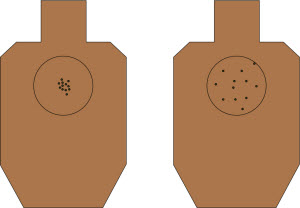
Which target shows a better understanding of precision in defensive shooting? The answer may surprise you.
“What can you say about these targets?” he asked the instructor candidates. “Good shooting!” exclaimed one student, the others joining in the ensuing laughter.
Rob looked a little puzzled. After all, the goal in defensive shooting is to make the bad guy go away using the least amount of time and energy necessary. Was spending time and energy to achieve smaller groups really a mark of good defensive shooting — or simply a display of meaningless athletic prowess?
“I don’t think,” he said, “that shooting more precisely than the target needs is good shooting.” He looked at me and said, “Grant, is there such a thing as too much precision?”
The implications of my answer caused me to rethink the whole notion of precision as a hallmark of defensive shooting.
What Has Gone Before
Let’s face it: we admire good shooters, those people who can place their shots exactly where they want them to go, one right next to another, time and time again. “Good shooting!” is a term of respect and approval — and perhaps not a small amount of envy. To be that shooter, to be capable of that feat, is an aspiration of many.
But is that what we should champion when talking about defensive shooting? For the last few decades it has been, but the results seem to be less than conclusive. Perhaps there is a better way, a way more congruent with the emerging state of the art in defensive training: the intersection of the realities of attacks and what we know about how the body deals with a threat.
This requires that we revisit our concepts of precision shooting as they relate to self-defense. Let’s get a few definitions out of the way before we jump into the discussion.
Terminology
Many people use the terms “accuracy” and “precision” interchangeably when discussing marksmanship. They’re not the same!
From a purely scientific point of view, accuracy refers to the nearness of a piece of data (a bullet) to a desired value (the bullseye of the target). To be accurate means that the bullet lands exactly where the shooter wanted it to go.
 Precision, on the other hand, refers to how similar each successive piece of data is to the first. In shooting terms, higher precision means that the bullets land closer to each other.
Precision, on the other hand, refers to how similar each successive piece of data is to the first. In shooting terms, higher precision means that the bullets land closer to each other.
The left target shows good accuracy — the bullets landed in and are centered on the desired place, which is the solid bullseye — but poor precision, since the group is rather large. The right target shows good precision — the shots are clustered together — but poor accuracy, as the shots are far from the intended landing spot.
As I said, these are the usual scientific or mathematical definitions of the terms. But there are also conceptual definitions of accuracy and precision that may be important to our application: to be accurate is to acknowledge a specific goal, while to be precise is to adhere to a degree of carefulness with regard to that goal.
Accuracy equates to validity and authenticity; precision means repeatability and reliability. Accuracy and precision are, in effect, similar concepts separated by chronology: a first shot is accurate or not, and repeated shots are precise (or not).
What does this have to do with defensive shooting?Shooter/Target Relationship
When you think about it, the target is really in control of our shooting decisions, particularly when we talk about shooting as a defensive activity. If our goal is to stop a threat (target) in the most efficient and reliable way, then we must hit it in an area that will result in the right kind of damage to cause it to cease physiological activity. We could certainly choose to shoot someplace else, but we’d be abandoning the goal (at our own peril).
It’s possible to cause the right kind of damage, but not enough of it. It’s also possible to cause a lot of damage, but not of the right kind. We have to do both — to cause the right kind of damage and enough of it to cause our threat to stop. On rare occasions, a single shot may achieve our goal, but that’s not something we can depend on. We must acknowledge that stopping a threat will most likely require a quantity of damage that can only be obtained with multiple shots.
If we were to fire only one shot, it would boil down to accuracy: did we hit what we targeted? If we fire more than one shot, the question becomes: did each bullet hit within the area of what we targeted?
It’s the target that dictates both the accuracy component — what or where we need to shoot — and the precision component — how carefully we need to place each additional shot. The target dictates accuracy simply by what it presents to us. If what we see is simply a frontal head, the kind of damage we need to do is to the neurological system, whose access point is the triangle made up of the eyes and nose. A full torso presents us with a very different kind of achievable damage. The accuracy required can also change from moment to moment, as the target and the shooter may both be moving, exposing or hiding the target area.
Accuracy and precision are therefore dynamic concepts, requiring that the shooter adapt to the situation, perhaps even during the incident. Once the target has shown us what kind of accuracy we need to have to do the kind of damage required, it’s up to the shooter to deliver the precision necessary to do a sufficient amount. The need for accuracy determines what we shoot at, what we target. The need for precision determines how carefully we’ll shoot at what we’ve targeted.
Precision as a Digital State
Let’s say that in a particular instance, the precision needed encompasses an area the size of an adult fist. To be precise, our shots would have to land inside that area. Shots outside that area would lack sufficient precision and wouldn’t be doing the amount of damage needed.
Don’t misunderstand: the damage any non-precise shots do may in fact be valuable and disruptive, but such damage is not equal to that caused by the shots that land in the target area itself. Inside that area, for all intents and purposes, each bullet can be considered equal in effect to every other bullet.
This concept is the basis of combat precision: the area in which any one hit is approximately equal in effect to any other hit.
As our task is to do sufficient damage to a particular thing, imprecise shots do not contribute to the success of that task. They do insufficient damage and thus waste the time, energy and ammunition that were expended. They are inefficient. Inefficient shots simply give the bad guy more time to hurt us or the people we’re protecting!
However, once the required level of combat precision has been achieved, any attempted increase is wasteful as well. If we accept the ideas that shots that meet the precision threshold are doing sufficient damage, and that each hit is going to be roughly equal to every other hit, then trying to place shots closer together (reaching a greater level of precision) does us no more good.
If we’re already hitting all shots in the heart, attempting to concentrate those shots in the left ventricle doesn’t really achieve anything additional. The extra time and effort that it takes to achieve this unneeded level of precision could be better spent shooting more. Once the combat precision threshold has been reached, it’s the number of shots, not how close to each other they land, that will determine the damage that stops the threat.
Delivering combat precision — the amount needed, no more and no less — is therefore the most efficient way to stop the threat. Since everything in defensive shooting is (or should be) evaluated by its effect on the target, and higher levels of precision beyond the threshold required do not result in greater effect, it holds that one cannot be “more precise” in the context of defensive shooting.
You either are or are not precise. There is no such thing as “better” once the threshold has been reached. Attempting to deliver more precision than the target requires is superfluous effort.
Not being sufficiently precise is inefficient, and being more than sufficiently precise is inefficient as well. How can the shooter, in the heat of the moment, know how much is enough?
Becoming an Expert
The defensive shooter has two decisions to make in an attack, and they come very rapidly: just before the first shot, what he’ll shoot; just before any succeeding shots, how carefully he’ll shoot. Given the short time frames of a violent assault, these decisions need to be made as quickly and efficiently as possible. This is the basis for my previous statement that accuracy and precision are similar concepts separated by time — a very brief amount of time!
We can have some foreknowledge about what level of precision will be necessary, because we know how the body is constructed. But we have to wait and see what accuracy we need to achieve, because we don’t know what part of the attacker will present itself. Accuracy and the need for precision are dictated by the target, but must be recognized by the shooter. The target is in control of the circumstances, while the shooter is in control of his/her response to those circumstances.
As it happens, delivering accuracy (the first shot) and precision (each additional shot) both require the same physical skills of deviation control — that is, the command over the gun that reduces the area in which the bullets might land. In order to hit a smaller target, or one farther away, the shooter applies more deviation control. In order to deliver additional shots within a specific area, the shooter applies deviation control continuously and dynamically.
The difference is in continuity. If we know we’re only going to fire one shot, we tend not to apply the necessary post-discharge control that sets us up for the next shot. If we know more shots are coming, we’ll apply follow-through control so that we maintain the deviation we desire.
A conscious decision-making approach to this process is relatively slow, as the brain must cognitively decide “this is what I want to hit,” then cognitively decide to fire another shot, and decide “this is how carefully I have to shoot.” Cognitive processes are inefficient. Can we make this kind of decision-making more efficient?
Yes. By training properly, the shooter can learn to recognize what he must shoot, recognize the precision with which it must be hit, and then recall the physical skill of deviation control to effect the hits. This process is far faster than cognitive thought and much better suited to adapting to the rapidly changing environment of a fight.
We can further reduce the time lag of the process by remembering the reality that a single shot from a handgun is unlikely to stop a violent attacker. If we make the decision ahead of time that we’re going to shoot until the threat stops, as opposed to shooting some predetermined number of shots and stopping to admire our work, we can compress the decision-making process still further.
Since we know that we’ll be shooting more than once, achieving combat precision becomes the primary task. It follows that if we’ve recognized the precision needed, we’ve already recognized the accuracy required — that at which we’re shooting. The recognition and decision of what to shoot and how carefully to shoot are made simultaneously. By focusing on combat precision, accuracy is automatically addressed.
The Expansion of Precision
When we consider that defensive shootings are dynamic and chaotic events, we have to accept that levels of precision cannot be exactly defined. Going back to our discussion of aiming for the heart, though it may be the most efficient route to target incapacitation, it’s probably not going to be practical to aim for it specifically while everyone (the attacker and defender) is in motion — the likely state of a violent confrontation.
In this case, our standards of accuracy and precision need to be redefined. The assailant might present us with his torso, which might mean that our level of combat precision, where any given shot is approximately equal in effect to any other shot, is an area centered on the upper portion of the chest. The size of that area is determined by the physiology of the target and how it is presented to us.
Aspiration Is Not a Valid Method
This is why seeking artificially high levels of precision during an incident is counterproductive to effective defensive shooting, and that working simply to become a “better shooter” may not be the best way to train to survive violent encounters.
As we’ve seen, there is not a single level of precision that is appropriate to all encounters. Physiology determines the most obvious aspects, but many other factors (including distance to the target) will be important as well. The dictated accuracy (what we must hit) doesn’t change, but the recognized precision (how carefully we must hit) certainly does!
This suggests that the highest efficiency is attained by focusing our efforts on being able to deliver appropriate levels of precision — no more, no less — on demand and without cognitive thought. The recognition of the precision needed should trigger a recall of the skills necessary to achieve it.
Researchers studying how the brain processes information tell us that the highest levels of data processing occur not through cognitive thought but from recall. The neocortex stores vast amounts of information that is accessed for decision-making much faster than inputs can be analyzed. By using this power of recognition and recall, humans make decisions faster and with less information.
Can the neocortex be purposely programmed to prepare for a defensive encounter in the way that it has been programmed for other kinds of rapid, non-perceptive decision-making?
The answer seems to be “yes.” For instance, Combat Focus Shooting uses this process (which it refers to as the “Warrior Expert Theory”) to build students’ skills. It acknowledges that experts learn to use their abilities of recognition and associative recall to make and execute decisions more efficiently. Training drills are structured to build this recognition/recall sequence by experience.Putting It to Work
How can this be done? Through frequent and realistic practice (“realistic” meaning to duplicate the circumstances under which the skill is needed, not necessarily the environment).
We could start by studying basic anatomy and physiology to learn the most effective target areas of an assailant. We could couple that with structured practice shooting at irregularly shaped and spaced targets presented to us randomly, as they would be in an actual incident.
The anatomy study is what would allow us to recognize the precision required, while the carefully conceived shooting drills allow us to associatively recall the motor control necessary to achieve a recognized precision. Given sufficient opportunities to experience these conditions (the “frequent” aspect noted above), we can develop the ability to do this much faster than we could consciously analyze it.
Such drills should force the student to recognize the precision needed and associate that with the physical skills to deliver that precision. This recognition and associative recall process is how shooting decisions are made at the most efficient pace. To develop that process, there must be options that the student has to face every time he shoots. By doing this, we dramatically reduce the shooter’s anticipation of the skill that will be needed.
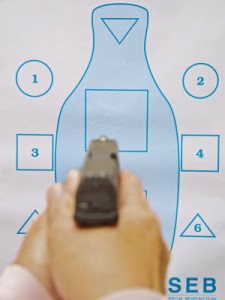
Having a training partner call out random targets of different shapes, sizes, and other attributes helps build the ability to recognize the precision needed.
In order to build the recognition and associative recall ability that make for expertise, anticipation must be reduced by providing options. Those options must be presented randomly, forcing the student to recognize the accuracy/precision needed and then recalling the necessary skills.
It’s the association of the recognition and the recalled skill that forms the links necessary for this highly efficient decision-making to happen. That can’t occur unless for any given drill there is more than one option — and it’s presented randomly.
Any attempt to define a “good defensive shooting group,” regardless of what the definition may be, dooms the process to failure because there is no recognition for the student to have.
Practice With Purpose
Does all this mean we abandon all traditional ideas of shooting well? Of course not, because we still have to be capable of the physical control necessary to achieve whatever degree of accuracy and precision shooting is needed. We still have to make the hits — that part has not changed!
This kind of reality-based training doesn’t mean less precision — but it doesn’t mean more, either. It means appropriate levels of precision for the task at hand, levels that the shooter recognizes and delivers. Once the level of precision has been recognized, the shooter can be confident in delivering shots at the maximum speed that he can get the hits needed. This is where efficiency is achieved.
From a training standpoint, being relieved of the burden of pursuing meaningless increments of precision means that we can spend our limited training resources in ways that will better help us defeat a threat in the least amount of time and with the least amount of effort. That should always be the goal.

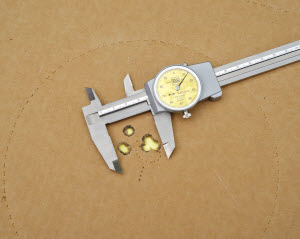
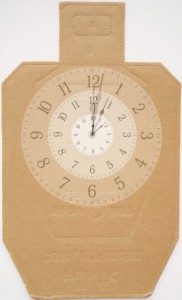
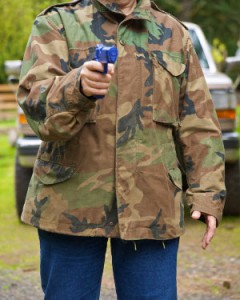
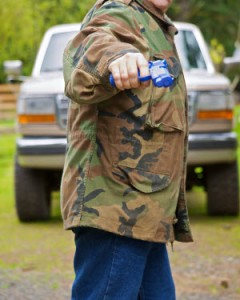
Thanks in favor off sharing such a pleasant idea, post is nice, thats why i have rezd it entirely
Hi there, I found your blog by way of Google whilst looking for a related subject, your site came up, it looks good. I have bookmarked to my favourites|added to my bookmarks.
When I have chance to teach somebody to hoot pistol hat exactly the idea I try to explain for defensive use of gun. The target shooting skills are no help for stressed first shot from the hip after pulling gun from the holster, unfortunately, hat I see at gun ranges are people standing like policemen and wasting expensive ammo to make the three inch group at fifteen yards.
This is the most in-depth, well thought out and reasoned analysis of combat accuracy that I've ever read. Well done, Grant.
All of this is makeing sence to me.
Grant, thank you for a truly comprehensive look at what is NEEDED in a training-to-fight plan. I've read countless ideas re: placement, speed vs. accuracy, "my way is the best way" ideas over the years; your article breaks down in an intelligent, well-thought-out manner where one might better spend time and effort. Will I still try to "ring the gong" at 100 yds.? Of course! But this explains traing to a purpose. I hope it spreads and saves lives.
Very interesting article. The theme of this was driven home in the first defensive shhoting class my wife and I took several years ago in Los Angeles.